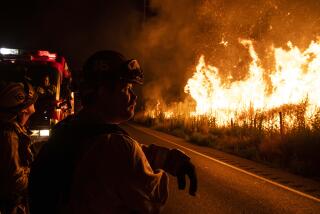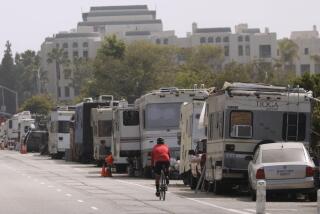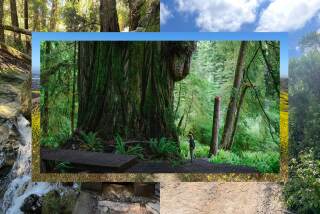Lawmakers’ plan would save some targeted California parks
- Share via
SACRAMENTO — Lawmakers are considering a new proposal to save dozens of state parks from the budget ax, rather than follow through with plans to close them in the middle of summer vacation season.
Seventy parks were set for closure to save money, and 20 could still be shut. Some have already been rescued, at least for the short term, by pledges from outside donors. But a proposal to charge for entrance at more parks, tap vehicle registration fees to maintain park roads and redirect other state funds would keep dozens more open.
All told, the new plan would make more than $40 million available annually to cover day-to-day costs and make overdue improvements, said the authors, state Sens. Joe Simitian (D-Palo Alto) and Noreen Evans (D-Santa Rosa).
“We took a step back and said there has to be a better way,” Simitian said in announcing the legislation Tuesday.
If the park closures occur, redwoods in Humboldt County on the north coast, the Salton Sea State Recreation Area and miles of sand dunes in Mendocino County could be blocked to visitors, as could Fort Tejon in Kern County and Saddleback Butte State Park in eastern Los Angeles County.
When a park is closed, the state closes its facilities and removes the rangers and other workers who assist visitors. Only one park has closed so far: Providence Mountain near the Mojave Desert, which was remote and understaffed.
Shutting a quarter of California’s 279 state-run parks is expected to save $22 million in the upcoming fiscal year, which begins July 1. That is a small fraction of Gov. Jerry Brown’s proposed $95.4-billion budget, and activists and lawmakers say the state should not risk the loss of tourism income or the illegal activity that could breed in unpatrolled parks.
The effect of the closures would not be limited to the state lands. Gary Ballard, who runs the Peg House, a food store just outside the Standish-Hickey State Recreation Area in Legett, in Mendocino County, said he wouldn’t be able to make payroll without the usual influx of summer visitors.
“If that [the park] closes up, pretty much the economy of the town of Legett does not have a lot going for it,” he said.
Outside donors and the federal government have swooped in to keep 16 parks open, at least temporarily. They include Jack London’s historic home north of Sonoma and McGrath Beach, south of Ventura, deemed one of the best bird-watching spots in California.
J. Daniel McCranie, a Silicon Valley entrepreneur, helped gather $900,000 to fund Henry W. Coe State Park, south of San Jose, for three years. McCranie said it was “kind of mind-bending” that the state needed donations to keep the parks open. But three decades of hiking in Coe left him attached to the nearly 90,000 acres of hills, valleys and wildflowers.
Many of the outside funding deals are temporary. “They’re not part of the long-term solution,” said Jerry Emory, spokesman for the California State Parks Foundation.
Simitian and Evans said their plan could augment the volunteer financing agreements and keep those parks open in the future as well.
The proposal faces its first test — vetting by a subcommittee — as early as Wednesday. But it’s already been blessed by Senate President Pro Tem Darrell Steinberg (D-Sacramento), whose spokesman Mark Hedlund called it a “thoughtful, comprehensive plan.”
The proposal received a cooler reception from Assembly Speaker John A. Pérez (D-Los Angeles). His spokesman, John Vigna, said the speaker wants to keep the parks open and is “considering all the available options.”
H.D. Palmer, a spokesman for Brown’s Department of Finance, said the administration had not yet reviewed the plan.
Times staff writer Nicholas Riccardi contributed to this report.
More to Read
Sign up for Essential California
The most important California stories and recommendations in your inbox every morning.
You may occasionally receive promotional content from the Los Angeles Times.











